The Impact of Skill Level on the Integration of Information and Post-Error Adjustment during Action Anticipation in Basketball
Abstract
:1. Introduction
1.1. Integration of Kinematic and Contextual Prior Information in Action Anticipation
1.2. Post-Error Adjustment in Action Anticipation
1.3. Aims and Hypotheses of This Study
2. Materials and Methods
2.1. Participants
2.2. Stimuli
2.3. Task and Procedure
2.4. Data Analysis
3. Results
3.1. Reaction Time
3.2. Accuracy
3.3. Analysis of Post-Error Adjustment
4. Discussion
4.1. Skill Level Impact on Action Anticipation: Integrating Contextual Prior and Kinematic Information
4.2. Skill Level Impact on Post-Error Adjustment in Action Anticipation
5. Conclusions
Author Contributions
Funding
Institutional Review Board Statement
Informed Consent Statement
Data Availability Statement
Conflicts of Interest
References
- Williams, A.M.; Jackson, R. Anticipation in sport: Fifty years on, what have we learned and what research still needs to be undertaken? Psychol. Sport Exerc. 2019, 42, 16–24. [Google Scholar] [CrossRef]
- Gredin, N.V.; Bishop, D.T.; Williams, A.M.; Broadbent, D.P. The use of contextual priors and kinematic information during anticipation in sport: Toward a bayesian integration framework. Int. Rev. Sport. Exerc. Psychol. 2020, 16, 286–310. [Google Scholar] [CrossRef]
- Runswick, O.R.; Roca, A.; Williams, A.M.; North, J.S. A model of information use during anticipation in striking sports (MIDASS). J. Expert. 2020, 3, 197–211. [Google Scholar]
- Runswick, O.R.; Roca, A.; Williams, A.M.; McRobert, A.P.; North, J.S. The Temporal Integration of Information during Anticipation. Psychol. Sport Exerc. 2018, 37, 100–108. [Google Scholar] [CrossRef]
- Harris, D.J.; North, J.S.; Runswick, O.R. A Bayesian Computational Model to Investigate Expert Anticipation of a Seemingly Unpredictable Ball Bounce. Psychol. Res. 2023, 87, 553–567. [Google Scholar] [CrossRef] [PubMed]
- Steinhauser, M.; Ernst, B.; Ibald, K.W. Isolating Component Processes of Posterror Slowing with the Psychological Refractory Period Paradigm. J. Exp. Psychol. Learn. Mem. Cogn. 2017, 43, 653–659. [Google Scholar] [CrossRef] [PubMed]
- Savelsbergh, G.J.; Williams, A.M.; Kamp, J.V.D.; Ward, P. Visual search, anticipation and expertise in soccer goalkeepers. J. Sports Sci. 2002, 20, 279–287. [Google Scholar] [CrossRef]
- Abernethy, B.; Zawi, K. Pickup of essential kinematics underpins expert perception of movement patterns. J. Mot. Behav. 2007, 39, 353–367. [Google Scholar] [CrossRef]
- North, J.S.; Williams, A.M.; Hodges, N.; Ward, P.; Ericsson, K.A. Perceiving patterns in dynamic action sequences: Investigating the processes underpinning stimulus recognition and anticipation skill. Appl. Cogn. Psychol. Off. J. Soc. Appl. Res. Mem. Cogn. 2009, 23, 878–894. [Google Scholar] [CrossRef]
- Aglioti, S.M.; Cesari, P.; Romani, M.; Urgesi, C. Action anticipation and motor resonance in elite basketball players. Nat. Neurosci. 2008, 11, 1109–1116. [Google Scholar] [CrossRef]
- Araújo, D.; Kirlik, A. Towards an ecological approach to visual anticipation for expert performance in sport. Int. J. Psychol. 2008, 39, 157–165. [Google Scholar]
- Lu, Y.; Yang, T.; Hatfield, B.D.; Cong, F.; Zhou, C. Influence of cognitive-motor expertise on brain dynamics of anticipatory-based outcome processing. Psychophysiology 2019, 57, e13477. [Google Scholar] [CrossRef] [PubMed]
- Zhao, Q.; Lu, Y.; Jaquess, K.J.; Zhou, C. Utilization of cues in action anticipation in table tennis players. J. Sports Sci. 2018, 36, 2699–2705. [Google Scholar] [CrossRef] [PubMed]
- Karlinsky, A.; Zentgraf, K.; Hodges, N.J. Action-skilled observation: Issues for the study of sport expertise and the brain. Prog. Brain Res. 2017, 234, 263–289. [Google Scholar] [CrossRef] [PubMed]
- Smith, D.M. Neurophysiology of action anticipation in athletes: A systematic review. Neurosci. Biobehav. Rev. 2016, 60, 115–120. [Google Scholar] [CrossRef]
- Abreu, A.M.; Macaluso, E.; Azevedo, R.T.; Cesari, P.; Urgesi, C.; Aglioti, S.M. Action anticipation beyond the action observation network: A functional magnetic resonance imaging study in expert basketball players. Eur. J. Neurosci. 2012, 35, 1646–1654. [Google Scholar] [CrossRef]
- Balser, N.; Lorey, B.; Pilgramm, S.; Naumann, T.; Kindermann, S.; Stark, R.; Zentgraf, K.; Williams, A.M.; Munzert, J. The influence of expertise on brain activation of the action observation network during anticipation of tennis and volleyball serves. Front. Neurosci. 2014, 8, 568. [Google Scholar] [CrossRef]
- Makris, S.; Urgesi, C. Neural underpinnings of superior action prediction abilities in soccer players. Soc. Cogn. Affect. Neurosci. 2015, 10, 342–351. [Google Scholar] [CrossRef]
- Wright, M.J.; Bishop, D.T.; Jackson, R.C.; Abernethy, B. Functional MRI reveals expert-novice differences during sport-related anticipation. Neuroreport 2010, 21, 94–98. [Google Scholar] [CrossRef]
- Farrow, D.; Reid, M. The contribution of situational probability information to anticipatory skill. J. Sci. Med. Sport 2012, 15, 368–373. [Google Scholar] [CrossRef]
- Loffing, F.; Hagemann, N. On-court position influences skilled tennis players’ anticipation of shot outcome. J. Sport Exerc. Psychol. 2014, 36, 14–26. [Google Scholar] [CrossRef] [PubMed]
- Gredin, N.V.; Bishop, D.T.; Broadbent, D.P.; Tucker, A.; Williams, A.M. Experts integrate explicit contextual priors and environmental information to improve anticipation efficiency. J. Exp. Psychol. Appl. 2018, 24, 509–520. [Google Scholar] [CrossRef] [PubMed]
- Gray, R.; Cañal-Bruland, R. Integrating visual trajectory and probabilistic information in baseball batting. Psychol. Sport Exerc. 2018, 36, 123–131. [Google Scholar] [CrossRef]
- Gredin, N.V.; Bishop, D.T.; Williams, A.M.; Broadbent, D.P. Integrating explicit contextual priors and kinematic information during anticipation. J. Sports Sci. 2021, 39, 783–791. [Google Scholar] [CrossRef] [PubMed]
- Vilares, I.; Kording, K. Bayesian Models: The Structure of the World, Uncertainty, Behavior, and the Brain. Ann. N. Y. Acad. Sci. 2011, 1224, 22–39. [Google Scholar] [CrossRef] [PubMed]
- Nakamoto, H.; Higuchi, T.; Mann, D.L. Kinaesthetic Cues When Predicting the Outcomes of the Actions of Others. J. Exp. Psychol. Hum. Percept. Perform. 2021, 47, 565–577. [Google Scholar] [CrossRef] [PubMed]
- Wu, Y.; Zeng, Y.; Zhang, L.; Wang, S.; Wang, D.; Tan, X.; Zhu, X.; Zhang, J.; Zhang, J. The Role of Visual Perception in Action Anticipation in Basketball Athletes. Neuroscience 2013, 237, 29–41. [Google Scholar] [CrossRef] [PubMed]
- Shadmehr, R. Learning to Predict and Control the Physics of Our Movements. J. Neurosci. 2017, 37, 1663–1671. [Google Scholar] [CrossRef] [PubMed]
- Tomeo, E.; Cesari, P.; Aglioti, S.M.; Urgesi, C. Fooling the Kickers but Not the Goalkeepers: Behavioral and Neurophysiological Correlates of Fake Action Detection in Soccer. Cereb. Cortex 2013, 23, 2765–2778. [Google Scholar] [CrossRef]
- Zhao, Q.; Wang, Y.; Chen, Y.; Wang, Y.; Zhou, C.; Lu, Y. Expertise Influences Congruency Monitoring during Action Observation at the Motor Level. Soc. Cogn. Affect. Neurosci. 2021, 16, 1288–1298. [Google Scholar] [CrossRef]
- Botvinick, M.M.; Braver, T.S.; Barch, D.M.; Carter, C.S.; Cohen, J.D. Conflict monitoring and cognitive control. Psychol. Rev. 2001, 108, 624–652. [Google Scholar] [CrossRef] [PubMed]
- Rabbitt, P.M.A. Error Correction Time without External Error Signals. Nature 1966, 212, 438. [Google Scholar] [CrossRef] [PubMed]
- Wang, Y.; Ji, Q.; Zhou, C. Effect of Prior Cues on Action Anticipation in Soccer Goalkeepers. Psychol. Sport Exerc. 2019, 43, 137–143. [Google Scholar] [CrossRef]
- Faul, F.; Erdfelder, E.; Lang, A.-G.; Buchner, A. G*Power 3: A Flexible Statistical Power Analysis Program for the Social, Behavioral, and Biomedical Sciences. Behav. Res. Methods 2007, 39, 175–191. [Google Scholar] [CrossRef] [PubMed]
- Macnamara, B.N.; Moreau, D.; Hambrick, D.Z. The relationship between deliberate practice and performance in sports: A meta-analysis. Perspect. Psychol. Sci. 2016, 11, 333–350. [Google Scholar] [CrossRef] [PubMed]
- Helm, F.; Cañal-Bruland, R.; Mann, D.L.; Troje, N.F.; Munzert, J. Integrating Situational Probability and Kinematic Information When Anticipating Disguised Movements. Psychol. Sport Exerc. 2020, 46, 101607. [Google Scholar] [CrossRef]
- Gredin, N.V.; Broadbent, D.P.; Findon, J.L.; Williams, A.M.; Bishop, D.T. The Impact of Task Load on the Integration of Explicit Contextual Priors and Visual Information during Anticipation. Psychophysiology 2020, 57, e13578. [Google Scholar] [CrossRef] [PubMed]
- Regev, S.; Meiran, N. Post-Error Slowing Is Influenced by Cognitive Control Demand. Acta Psychol. 2014, 152, 10–18. [Google Scholar] [CrossRef]
- Broadbent, D.P.; Gredin, N.V.; Rye, J.L.; Williams, A.M.; Bishop, D.T. The impact of contextual priors and anxiety on performance effectiveness and processing efficiency in anticipation. Cogn. Emot. 2018, 33, 389–596. [Google Scholar] [CrossRef]
- Simonet, M.; Meziane, H.B.; Runswick, O.R.; North, J.S.; Williams, A.M.; Barral, J.; Roca, A. The Modulation of Event-Related Alpha Rhythm during the Time Course of Anticipation. Sci. Rep. 2019, 9, 18226. [Google Scholar] [CrossRef]
- Gabbett, T.J.; Abernethy, B. Expert–Novice Differences in the Anticipatory Skill of Rugby League Players. Sport Exerc. Perform. Psychol. 2013, 2, 138–155. [Google Scholar] [CrossRef]
- Mori, S.; Shimada, T. Expert Anticipation from Deceptive Action. Atten. Percept. Psychophys. 2013, 75, 751–770. [Google Scholar] [CrossRef] [PubMed]
- Li, Q.X.; Hu, N.; Li, Y.; Long, Q.; Gu, Y.; Tang, Y.; Chen, A. Error-Induced Adaptability: Behavioral and Neural Dynamics of Response-Stimulus Interval Modulations on Posterror Slowing. J. Exp. Psychol. Gen. 2021, 150, 851–863. [Google Scholar] [CrossRef] [PubMed]
- Ridderinkhof, K.R.; Ullsperger, M.; Crone, E.A.; Nieuwenhuis, S. The Role of the Medial Frontal Cortex in Cognitive Control. Science 2004, 306, 443–447. [Google Scholar] [CrossRef] [PubMed]
- Somers, M.; Shields, L.S.; Boks, M.P.; Kahn, R.S.; Sommer, I.E. Cognitive benefits of right-handedness: A meta-analysis. Neurosci. Biobehav. Rev. 2015, 51, 48–63. [Google Scholar] [CrossRef]
- Loffing, F.; Cañal-Bruland, R. Anticipation in Sport. Curr. Opin. Psychol. 2017, 16, 6–11. [Google Scholar] [CrossRef]
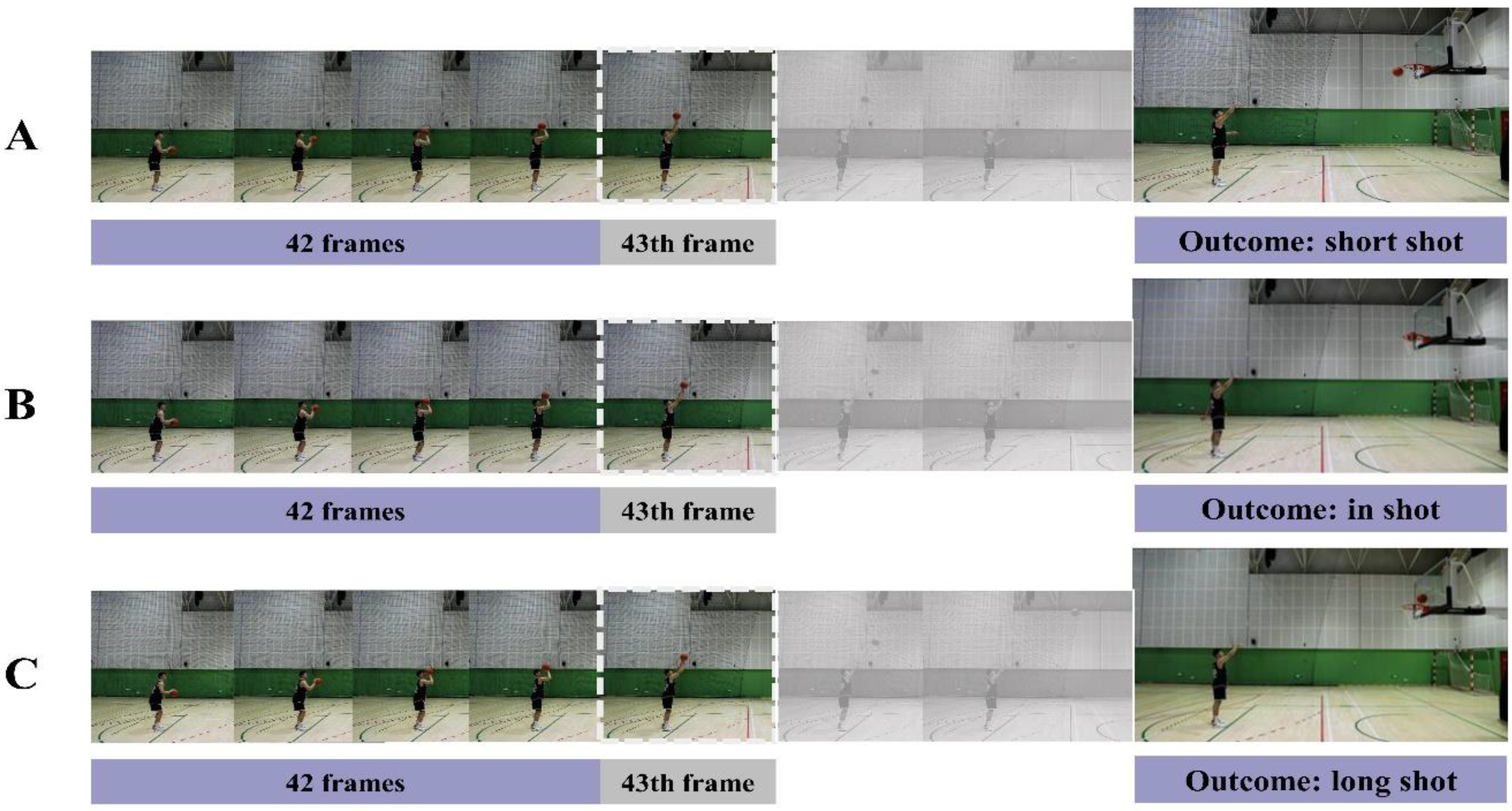
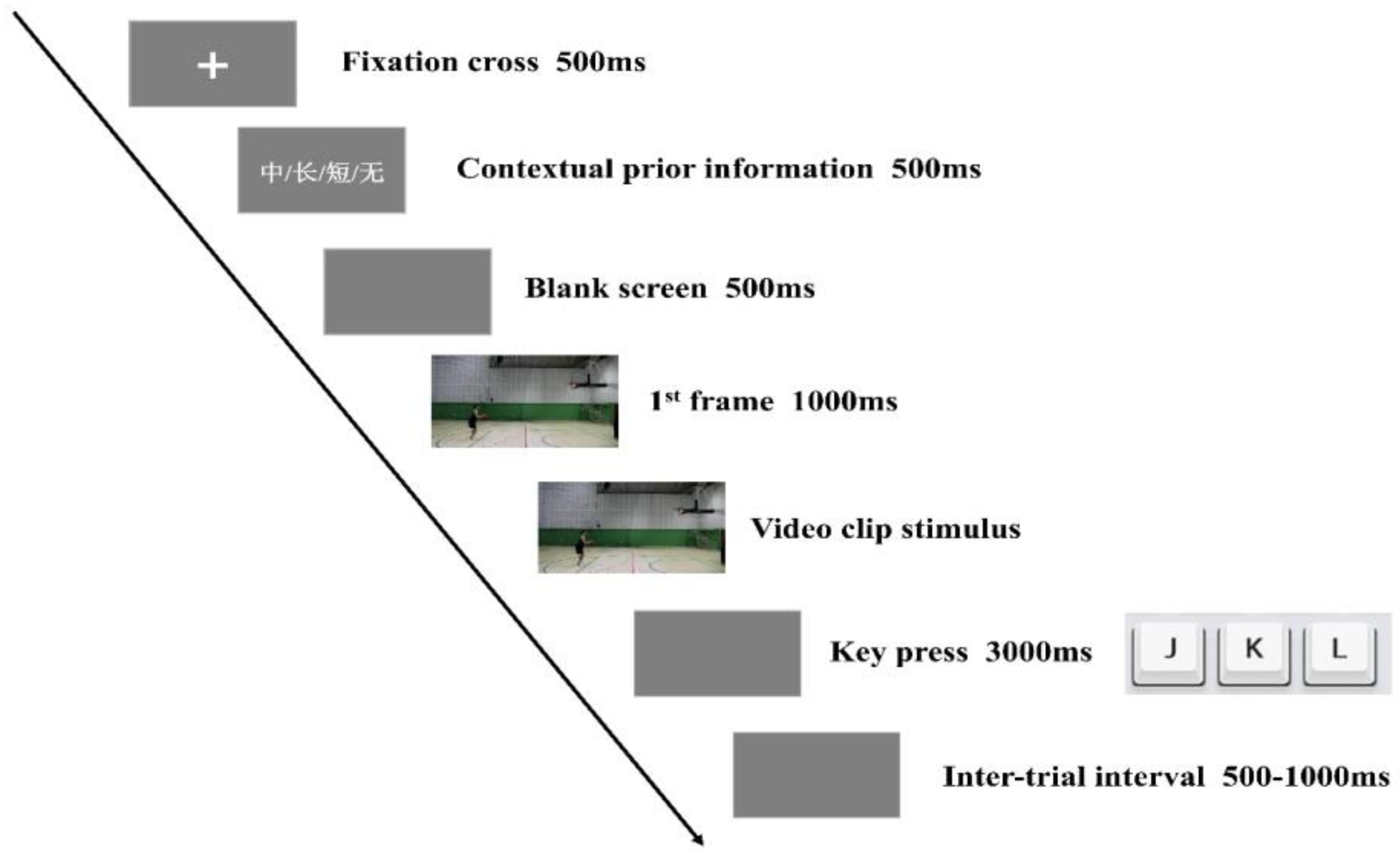
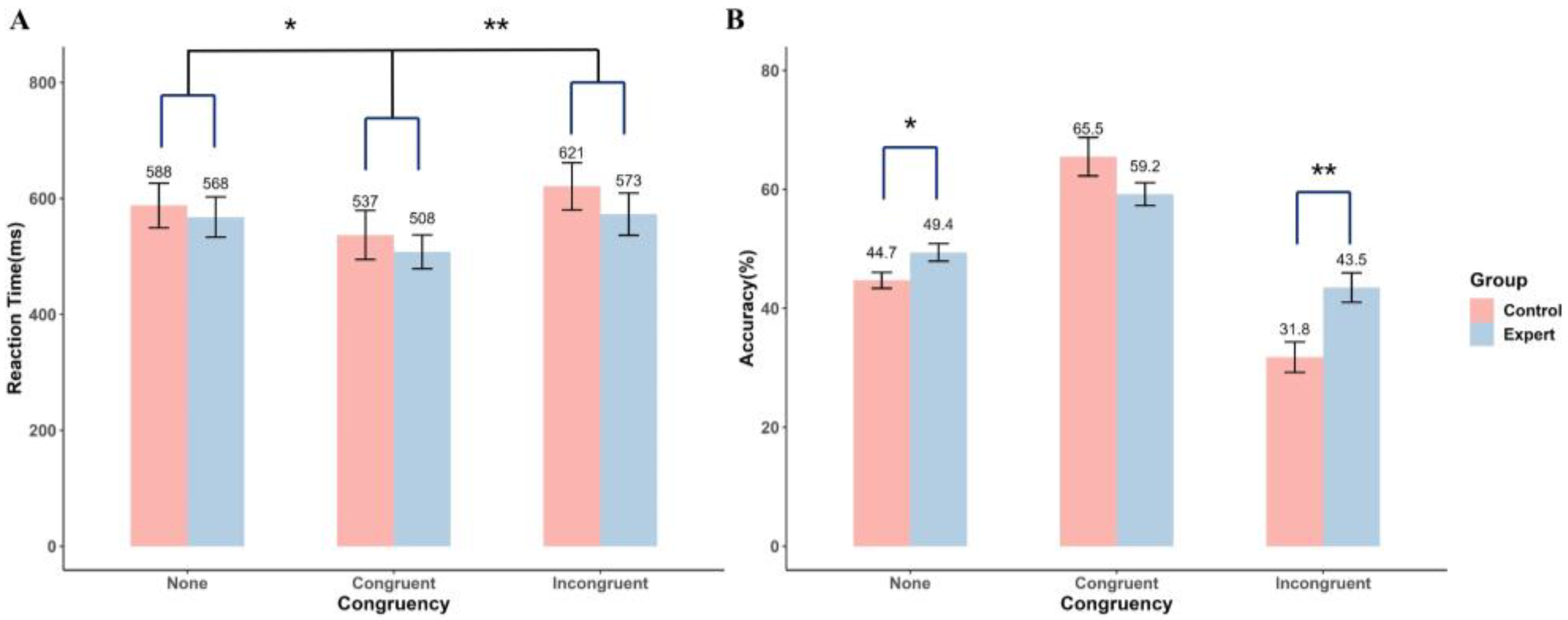
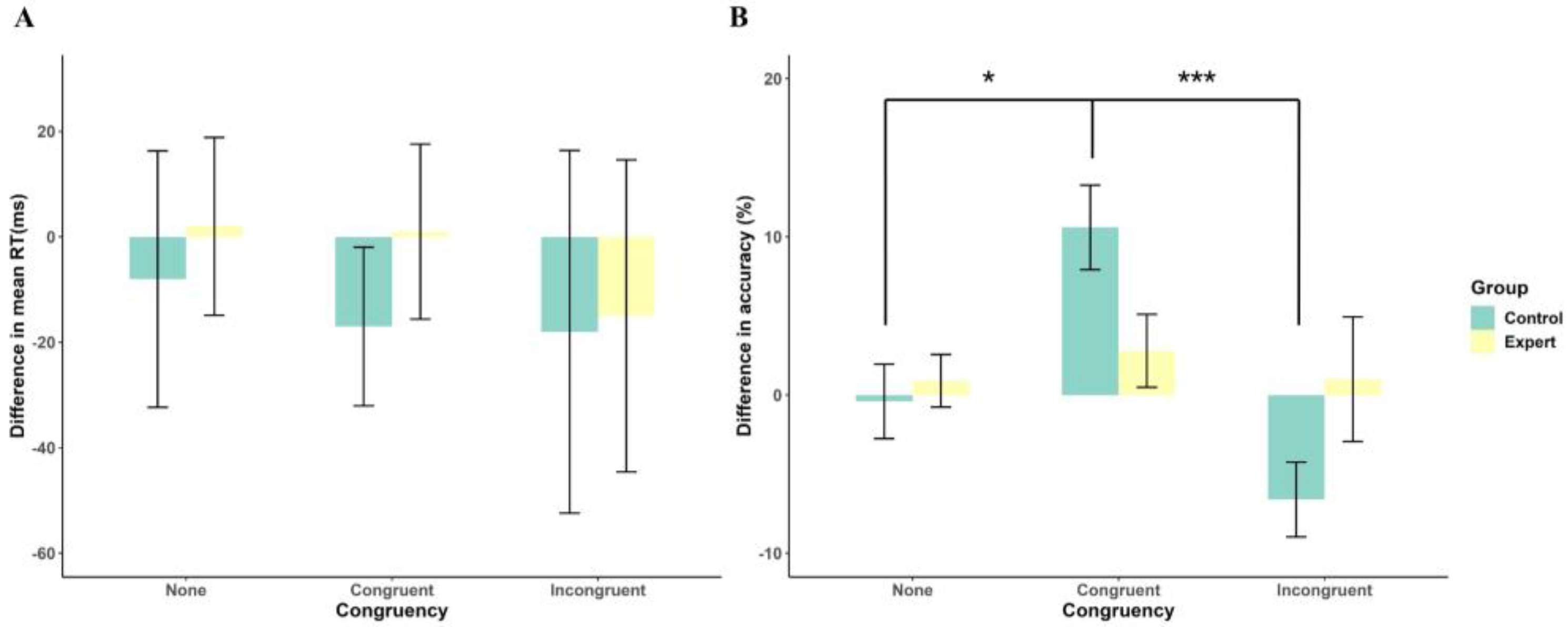
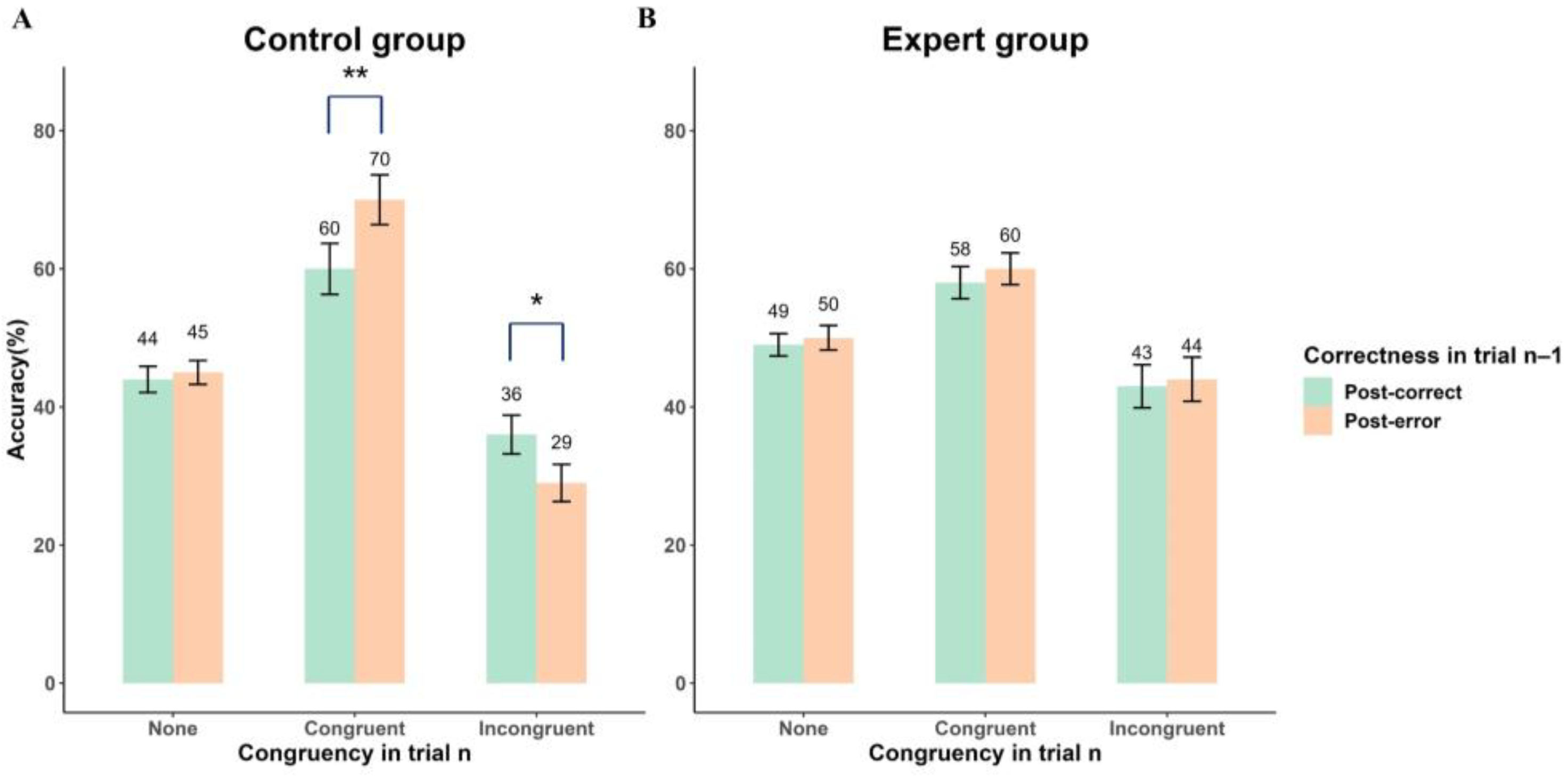
| Experts | Controls | |
|---|---|---|
| Number | 23 | 23 |
| Age, mean ± SD, years | 20.17 ± 1.07 | 19.8 ± 1.64 |
| Years of training, mean ± SD | 8.17 ± 2.17 | 0 |
| Training frequency (days/week) | 5–7 | 0 |
| Training time (hours/day) | 4–5 | 0 |
| Body mass index, mean ± SD | 23.62 ± 2.01 | 20.38 ± 3.29 |
Disclaimer/Publisher’s Note: The statements, opinions and data contained in all publications are solely those of the individual author(s) and contributor(s) and not of MDPI and/or the editor(s). MDPI and/or the editor(s) disclaim responsibility for any injury to people or property resulting from any ideas, methods, instructions or products referred to in the content. |
© 2024 by the authors. Licensee MDPI, Basel, Switzerland. This article is an open access article distributed under the terms and conditions of the Creative Commons Attribution (CC BY) license (https://creativecommons.org/licenses/by/4.0/).
Share and Cite
Chen, Z.; Wang, D.; Fang, W.; Luan, M. The Impact of Skill Level on the Integration of Information and Post-Error Adjustment during Action Anticipation in Basketball. Behav. Sci. 2024, 14, 423. https://doi.org/10.3390/bs14050423
Chen Z, Wang D, Fang W, Luan M. The Impact of Skill Level on the Integration of Information and Post-Error Adjustment during Action Anticipation in Basketball. Behavioral Sciences. 2024; 14(5):423. https://doi.org/10.3390/bs14050423
Chicago/Turabian StyleChen, Zhefu, Danlei Wang, Wenxuan Fang, and Mengkai Luan. 2024. "The Impact of Skill Level on the Integration of Information and Post-Error Adjustment during Action Anticipation in Basketball" Behavioral Sciences 14, no. 5: 423. https://doi.org/10.3390/bs14050423
APA StyleChen, Z., Wang, D., Fang, W., & Luan, M. (2024). The Impact of Skill Level on the Integration of Information and Post-Error Adjustment during Action Anticipation in Basketball. Behavioral Sciences, 14(5), 423. https://doi.org/10.3390/bs14050423






